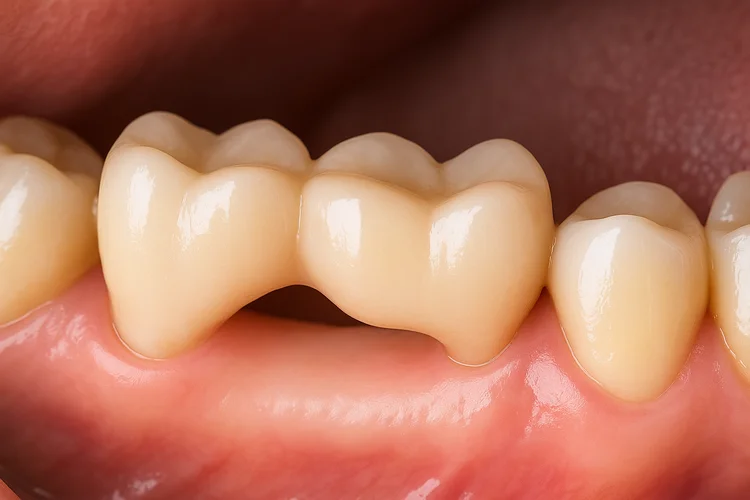A dental bridge isn’t just a cosmetic solution. It’s a functional restoration that depends heavily on how well you maintain it. The care you provide within the first 48 hours and the habits you adopt long term directly impact how long your bridge lasts and how well it supports your oral health. Whether you’ve just had a dental bridge placed or want to ensure its longevity, this article is for you. Because we are going to demonstrate how to properly take care after having a dental bridge.

What Is a Dental Bridge?
A dental bridge is a fixed restoration used to replace one or more missing teeth by anchoring to adjacent natural teeth or implants. It fills the space left by missing teeth, restores proper bite alignment, and prevents the surrounding teeth from shifting.
Bridges are typically made from porcelain fused to metal, ceramic, or zirconia, and can be customized to match the natural teeth in appearance and function.
Many people don’t know how to take care after having a dental bridge and that’s why you have to pay more attention to the rest of this article.
Immediate Post-Procedure Care: The First 24–48 Hours
After receiving a dental bridge, it’s normal to experience mild sensitivity or tenderness in the surrounding gums and teeth. This usually improves within a couple of days, but the way you take care after having a dental bridge during the first 24–48 hours is crucial to ensure comfort and long-term success.
Here are the most critical steps to take in order to properly take care after having a dental bridge:
- Be mindful of what you eat: Avoid hard, crunchy, or sticky foods that put unnecessary pressure on the new bridge. If you received anesthesia, wait until full sensation returns before eating to avoid accidentally biting your cheek or tongue.
- Start gentle cleaning: Brush carefully the same evening using a soft-bristle toothbrush. Floss gently, paying special attention to the area around the bridge, but avoid forcing the floss if the area feels tender.
- Follow your dentist’s instructions: If you’ve been prescribed antibiotic rinses or recommended over-the-counter pain relief, use them exactly as directed.
- Use cold compresses if needed: Applying a cold compress on the outside of your cheek can help reduce swelling and ease mild discomfort during the first 24 hours.
- Monitor your recovery: Mild discomfort is expected, but persistent pain, swelling, or bite issues should be addressed promptly. If symptoms persist, contact an emergency dentist promptly for evaluation and treatment.
By taking these precautions during the first 24–48 hours, you’ll minimize discomfort and give your dental bridge the best chance to settle properly. Early care not only helps with healing but also prevents avoidable complications. And if unexpected issues arise, contacting an emergency dentist ensures they can be addressed quickly and effectively.
Read more: Emergency Dentistry For Toothache

Daily Maintenance Tips
Oral hygiene is essential for the success of any dental bridge. While the prosthetic tooth itself cannot decay, the supporting teeth and surrounding gums remain vulnerable. Brush twice a day using fluoride toothpaste and pay close attention to the gum line near the bridge. Flossing under the bridge is crucial to prevent plaque buildup and inflammation. Use a floss threader or water flosser to clean beneath the pontic (the artificial tooth). These tips have always been at the top of the list for people who are trying to take care after having a dental bridge.
Read More: Benefits of flossing
Regular use of antimicrobial mouthwash helps reduce bacteria in hard-to-reach areas of the mouth. Be sure to attend your routine check-ups and cleanings, where our general dentistry team will examine the bridge and assess the health of the supporting teeth and gums.
Here’s a helpful overview of the key habits for maintaining your bridge:
| Phase of Care | Key Actions | Why It Matters |
| First 48 Hours | Soft diet, gentle brushing, avoid chewing on the bridge side | Allows healing and protects the new restoration |
| Daily Oral Hygiene | Brush and floss thoroughly, especially under the bridge | Prevents decay and gum inflammation around supporting teeth |
| Professional Maintenance | Schedule check-ups, cleanings, and x-rays regularly | Detects early problems and extends the lifespan of the bridge |
| Protective Measures | Avoid hard foods, manage bruxism with a nightguard if needed | Prevents mechanical damage and stress fractures |
| Specialist Support (if needed) | Consider periodontal or restorative assessment for long-term preservation | Supports overall bridge stability and surrounding tissue health |
Long-Term Care for Your Bridge
The success of a dental bridge relies not only on daily cleaning but also on bite management and general health. Avoid using your bridge to bite down on ice, hard candy, or pens, as excessive force can cause cracks or dislodge the restoration. Bruxism (teeth grinding) can also damage bridges, so we may recommend a custom nightguard if grinding is observed.
Over time, the supporting teeth may require maintenance, especially if decay develops or gum disease progresses. That’s why patients with bridges benefit from regular periodontal assessments and, when needed, adjunct care through our periodontics services. Early intervention preserves both the bridge and the underlying structures that support it.
Here is the Colgate website’s take on dental bridge care:
Dental hygiene is an essential factor in your bridge’s long-term success. Take motivation from the fact that bridges can last over ten years with proper care.
Contact Us
At My Dentist Langley, we provide the best dental check-ups so that
You no longer have to worry about your dental bridges.
Lasting Success Depends on How You Take Care After Having a Dental Bridge
Dental bridges can last well over a decade when patients commit to excellent oral care and professional maintenance. The earliest phase in those first 48 hours sets the tone for healing. However, the best results come from sustained habits, which include cleaning under the bridge, protecting the restoration from pressure, and regular check-ins with your dentist.
At Dentist Langley, we are proud to say that we are improving lives with a comprehensive range of services today that will save you from emergency dental repairs tomorrow, alongside providing tips on how to take care after having a dental bridge.
FAQ
Patients often have specific questions once their bridge is placed. Below are the most common concerns we hear at Dentist Langley.
-
How soon can I eat after getting a dental bridge?
You should wait until the numbness from anesthesia wears off. After that, start with soft foods and chew on the opposite side for the first 24 hours. Avoid anything hard or sticky during this period.
-
Can I floss under my dental bridge?
Yes, and you should. Use a floss threader or water flosser to clean underneath the pontic daily. Proper cleaning prevents plaque buildup and protects the supporting teeth.
-
What foods should I avoid with a bridge?
Avoid chewing hard candy, nuts, ice, or very sticky foods like caramel. These can crack or loosen the bridge over time. Also, be cautious with foods that require excessive force to bite.
-
How long does a dental bridge last with reasonable care?
With excellent hygiene and regular check-ups, a bridge can last anywhere from 10 to 15 years, or even longer. Maintenance of the supporting teeth is key to longevity.
-
What if my bridge feels loose?
A loose bridge can indicate issues with the cement, supporting teeth, or bite pressure. Do not ignore this. Contact us immediately to assess the problem and avoid complications
Our experts are waiting for you in the comments section to answer all of your questions about dental bridges.




